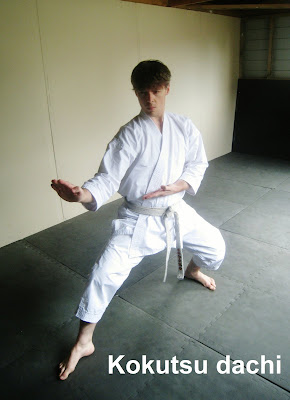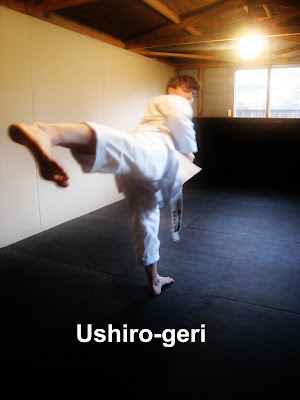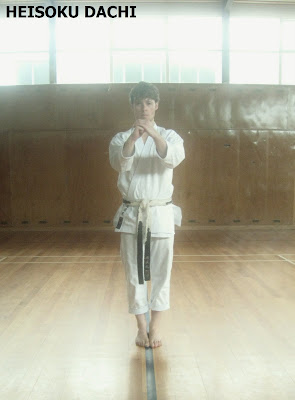This site is based on my daily practice of Shotokan Karate-Do here in Oita City, Japan. More than anything else, unlike the majority of other karate websites, this page is primarily dedicated to Budo Karate training itself; that is, Karate-Do as a vehicle for holistic development.
Tuesday, 29 March 2011
Sunday, 20 March 2011
TACIT KARATE
 The majority of highly advanced techniques, principles and applications in karate can be best explained as tacit or unspoken knowledge.
The majority of highly advanced techniques, principles and applications in karate can be best explained as tacit or unspoken knowledge. are most effective at close range, typically in a self-defense context to finish an attacker. If explicitly taught with their respective kyusho (vital points) they are extremely dangerous, even performed with moderate power. A very basic example could be a seiken hasami-zuki simultanously impacting on the opponents throat and base of their skull (first cervical vertebra).
are most effective at close range, typically in a self-defense context to finish an attacker. If explicitly taught with their respective kyusho (vital points) they are extremely dangerous, even performed with moderate power. A very basic example could be a seiken hasami-zuki simultanously impacting on the opponents throat and base of their skull (first cervical vertebra).Of course other traditional karate styles such as Goju-ryu, Wado-ryu, Shito-ryu, Uechi-ryu, Ryuei-ryu and Shorin-ryu also have these techniques, which are equally effective, but with slightly different form.
________
The widespread use of double punches in all of the traditional styles is highly indicative of how much they were valued by the old masters and effectively employed in hand-to-
Saturday, 19 March 2011
What's your stance? (The Draft)
 From a constructivist view point, especially when considering that this website follows my daily training and teaching, here are some of the photos from the original 'What's your stance' article, which I actually wrote last year (For the article please click here: http://andrebertel.blogspot.com/2011/03/taking-stance.html). Usually the articles are written a few months ahead of time, as I can never write for more than 15 minutes at any given time, due to my university schedule, personal life and daily karate commitments. Rather than harp on, I thought I'd make this post to give some insight on how I produce the content on here. All the very best, Osu!
From a constructivist view point, especially when considering that this website follows my daily training and teaching, here are some of the photos from the original 'What's your stance' article, which I actually wrote last year (For the article please click here: http://andrebertel.blogspot.com/2011/03/taking-stance.html). Usually the articles are written a few months ahead of time, as I can never write for more than 15 minutes at any given time, due to my university schedule, personal life and daily karate commitments. Rather than harp on, I thought I'd make this post to give some insight on how I produce the content on here. All the very best, Osu! 
Thursday, 17 March 2011
Taking a stance!
 The tachikata (stances) of Asai-ha Shotokan-ryu Karate include heisoku dachi, musubi dachi, heiko dachi, hachinoji dachi, uchi hachinoji dachi, renoji dachi, teiji dachi, kosa dachi, neko ashi dachi, sanchin dachi, hangetsu dachi, shokutsu dachi, zenkutsu dachi, kiba dachi, kokutsu dachi, fudo dachi and others. They are all essentially `transitional positions' or `landing gears' to launch, deliver, recover from, or to `set up' various techniques/combinations. This is especially the case when considering the effective oyo (practical application) of kata.
The tachikata (stances) of Asai-ha Shotokan-ryu Karate include heisoku dachi, musubi dachi, heiko dachi, hachinoji dachi, uchi hachinoji dachi, renoji dachi, teiji dachi, kosa dachi, neko ashi dachi, sanchin dachi, hangetsu dachi, shokutsu dachi, zenkutsu dachi, kiba dachi, kokutsu dachi, fudo dachi and others. They are all essentially `transitional positions' or `landing gears' to launch, deliver, recover from, or to `set up' various techniques/combinations. This is especially the case when considering the effective oyo (practical application) of kata. Shotokan-ryu Karatedo all the more important, as we are keeping Sensei's technical legacy alive by our practice.
Shotokan-ryu Karatedo all the more important, as we are keeping Sensei's technical legacy alive by our practice.




Keriwaza II: Form & strength first, flexibility second.
 I was swamped by emails after my last post titled `keriwaza’ so rather than answer everyone individually, I thought I’d make post answering ‘the consistent inquisition’: “How can I improve my flexibility for kicking?” Originally I decided to post with a bit of humour… However I amended this, deciding to answer the `main question' sensibly. All the very best in your endeavours, Osu! André Bertel.
I was swamped by emails after my last post titled `keriwaza’ so rather than answer everyone individually, I thought I’d make post answering ‘the consistent inquisition’: “How can I improve my flexibility for kicking?” Originally I decided to post with a bit of humour… However I amended this, deciding to answer the `main question' sensibly. All the very best in your endeavours, Osu! André Bertel.__________
Too much focus on flexibility: Personally I believe this is where many people go wrong. My advice is to first and fore mostly develop form and strength, and SLOWLY build up flexibility to increase range of motion. Aim to have perfect gedan and chudan traditional keriwaza in slow motion and with maximum speed. If effective TRADITIONAL jodan techniques are not possible, just forget them! What I mean by `traditional keriwaza’ are kicks which travel a high path and smash upward, downward or directly into/onto the opponent with effective weapons i.e. – mawashi-geri coming down with josokutei (the ball of the foot) or sune (the shin); ushiromawashi-geri with kakato (the heel) etc.
 __________
__________If you are interested in actual stretching methods or ways to improve you kicks, please do some searches here on my blog via the search engine at the top left corner of the page.
© André Bertel, New Zealand 2011.
Wednesday, 16 March 2011
Keriwaza I
 There are many keriwaza (kicking techniques) in Shotokan Karate-Do, the more common include mae hiza geri, mae geri (keage and kekomi), fumikomi, yoko geri (keage and kekomi), ushiro geri (kekomi and keage), mawashi hiza geri, mawashi geri, gyaku mawashi geri, mikazuki geri, ura mikazuki geri, kakato otoshi geri, ura mawashi geri, ushiromawashi-geri etc.
There are many keriwaza (kicking techniques) in Shotokan Karate-Do, the more common include mae hiza geri, mae geri (keage and kekomi), fumikomi, yoko geri (keage and kekomi), ushiro geri (kekomi and keage), mawashi hiza geri, mawashi geri, gyaku mawashi geri, mikazuki geri, ura mikazuki geri, kakato otoshi geri, ura mawashi geri, ushiromawashi-geri etc. that you do come up onto your toes, even if you are trying to keep the heel down. Now try the same thing coming up onto your toes... If you don't fall over, you will find that your kick is not nearly as effective. Of course this also applies to punches and strikes. The OVEREMPHASIS of keeping the heel down has its origins not in the traditional Martial-Art of Karate but rather in modern transformation of karate [kata] into an aesthetic sport.
that you do come up onto your toes, even if you are trying to keep the heel down. Now try the same thing coming up onto your toes... If you don't fall over, you will find that your kick is not nearly as effective. Of course this also applies to punches and strikes. The OVEREMPHASIS of keeping the heel down has its origins not in the traditional Martial-Art of Karate but rather in modern transformation of karate [kata] into an aesthetic sport. at I have employed higher front kicks with "great success" whilst working in the security industry, and I've seen others also do this. But again I have to emphasise, the snap kick to the shin or groin followed by the elbow or punch to the head/face is far more consistent...
at I have employed higher front kicks with "great success" whilst working in the security industry, and I've seen others also do this. But again I have to emphasise, the snap kick to the shin or groin followed by the elbow or punch to the head/face is far more consistent... by being able to reactively use the body as a weapon from, and to, any position, without the need for any conscious thought." This Asai-ha Shotokan-ryu training philosophy means that all techniques, including all keriwaza, must be intensively practiced and made second nature.
by being able to reactively use the body as a weapon from, and to, any position, without the need for any conscious thought." This Asai-ha Shotokan-ryu training philosophy means that all techniques, including all keriwaza, must be intensively practiced and made second nature.© André Bertel. Christchurch, New Zealand 2011.
Monday, 14 March 2011
Jiyu kumite no kamae
 The 'Jiyu-kumite no kamae' (posture of free-sparring) in traditional karate refers to the position of the upper body and arms in particular. Here I'm in a typical `kamae' which allows a direct lead hand jodan attack or defence and middle and upper level attacks or defenses with the rear hand.
The 'Jiyu-kumite no kamae' (posture of free-sparring) in traditional karate refers to the position of the upper body and arms in particular. Here I'm in a typical `kamae' which allows a direct lead hand jodan attack or defence and middle and upper level attacks or defenses with the rear hand.________
Sunday, 13 March 2011
Techniques from any movement or position: The Unpredictability of Asai Karate

 Asai Sensei taught me that such "very easy" exercises are important in foundational training. Likewise, the more advanced jumping, rotation and reverse rotational movements are critical, and beyond these, the combinations of anything without thought! For example attacking with an oi-zuki going to the ground with tate hiza dachi, immediately coming up and rotating into kiba dachi with ushiro empi uchi, then jumping and reverse rotating into kosa-dachi with shuto uchi etc. Possibilities are limitless, which adds unpredictability to one’s karate.
Asai Sensei taught me that such "very easy" exercises are important in foundational training. Likewise, the more advanced jumping, rotation and reverse rotational movements are critical, and beyond these, the combinations of anything without thought! For example attacking with an oi-zuki going to the ground with tate hiza dachi, immediately coming up and rotating into kiba dachi with ushiro empi uchi, then jumping and reverse rotating into kosa-dachi with shuto uchi etc. Possibilities are limitless, which adds unpredictability to one’s karate.
Saturday, 12 March 2011
JAPAN EARTHQUAKE
 New Zealand and Japan are our home countries, Mizuho & I have both lived in both nations extensively over the years, and both have been attacked by natural disasters in the last few weeks. Our love, thoughts and prayers are with our family and friends in Japan, and all of those suffering from this catastrophic chain of events.
New Zealand and Japan are our home countries, Mizuho & I have both lived in both nations extensively over the years, and both have been attacked by natural disasters in the last few weeks. Our love, thoughts and prayers are with our family and friends in Japan, and all of those suffering from this catastrophic chain of events.KUMITE
 The definition of ‘Kumite’ by the late Chief Instructor of the Japan Karate Association, Masatoshi Nakayama Sensei, is worthy of much reflection: “Kumite is a method in training in which the offensive and defensive techniques learned in the kata are given practical application. The opponents are face to face. The importance of kata to kumite cannot be overemphasized. If techniques are used unnaturally or in a forced way, posture will break down. And if the kata techniques become confused when applied, no improvement in kumite can be expected. In other words, improvement in kumite depends directly on moving in kata; the two go together like hand in glove. It is a mistake to emphasize one at the expense of the other. This is a point to be careful about when practicing kumite.” - MASATSOHI NAKAYAMA `BEST KARATE 3: KUMITE 1'.
The definition of ‘Kumite’ by the late Chief Instructor of the Japan Karate Association, Masatoshi Nakayama Sensei, is worthy of much reflection: “Kumite is a method in training in which the offensive and defensive techniques learned in the kata are given practical application. The opponents are face to face. The importance of kata to kumite cannot be overemphasized. If techniques are used unnaturally or in a forced way, posture will break down. And if the kata techniques become confused when applied, no improvement in kumite can be expected. In other words, improvement in kumite depends directly on moving in kata; the two go together like hand in glove. It is a mistake to emphasize one at the expense of the other. This is a point to be careful about when practicing kumite.” - MASATSOHI NAKAYAMA `BEST KARATE 3: KUMITE 1'.Nakayama Sensei goes on to explain three broad categories of kumite. I will continue to directly quote him here: “Basic kumite, jiyu ippon kumite and jiyu-kumite are three types of kumite.
In this most elementary form of kumite, the opponents take a fixed distance from each other and the target is agreed on beforehand. They then alternately practice blocking and attacking. This may be done as a single block and attack–ippon kumite–or a series of five–gohon kumite.
Jiyu ippon kumite
The late Minoru Miyata was my classmate and a colleague of mine since the founding of the Japan Karate Association. From his long years of experience, he held a clearly defined view of jiyu ippon kumite and jiyu kumite. Since he was a man who capabilities were highly evaluated by others and one whom I had very great confidence. I would like to quote him on this subject. The method of jiyu ippon kumite is this. Both men take a kamae freely at an optional distance. Announcing the area he is aiming for, the attacker attacks decisively. Against this the blocker freely uses techniques he has mastered and counterattacks at once. This is a training method; the purpose is to put into actual practice the techniques of offense and defence. This is jissen (actual fighting) kumite.” - MASATOSHI NAKAYAMA `BEST KARATE 3 - KUMITE 1'. Nakayama Sensei doesn't mention Kaeshi ippon kumite in 'Best Karate' but for those who do not practice Shotokan, I believe it is best defined (in brief) as "a form of Jiyu ippon kumite which develops `attacking zanshin".
_________

© André Bertel. Christchurch, New Zealand 2011.
Thursday, 10 March 2011
Christchurch Earthquake Update: Train harder!
 The earthquake has resulted in the Shirley Boys High School Gym to be 'red stickered' therefore the dojo will have to move. We will update you ASAP on this situation. Regardless, please keep up your self-training!
The earthquake has resulted in the Shirley Boys High School Gym to be 'red stickered' therefore the dojo will have to move. We will update you ASAP on this situation. Regardless, please keep up your self-training!All the aftershocks should make you train harder. OSU!!!
Wednesday, 9 March 2011
OI-ZUKI
 Oi-zuki (chasing punch) is often referred to as the `lunge punch’. Oi-zuki along with the gyaku-zuki (reverse punch) and mae-geri (front kick) are the core offensive techniques in Shotokan style karate. Without the mastery and on-going `sharpening' of these foundational techniques, everything else is irrelevant. Oi-zuki is of particular importance as even in its most basic form develops fundamental koshi no kaiten (hip rotation) and tai no shinshuku (the compression and expansion of the body).
Oi-zuki (chasing punch) is often referred to as the `lunge punch’. Oi-zuki along with the gyaku-zuki (reverse punch) and mae-geri (front kick) are the core offensive techniques in Shotokan style karate. Without the mastery and on-going `sharpening' of these foundational techniques, everything else is irrelevant. Oi-zuki is of particular importance as even in its most basic form develops fundamental koshi no kaiten (hip rotation) and tai no shinshuku (the compression and expansion of the body).________
In addition to these points, relaxation to achieve superior snap, and various timing is developed in relation to the punch and propulsion of the stance. This eventually takes the technique away from being `merely oi-zuki’ (I.e - a subtle change in timing can easily turn it into oi-komi gyaku-zuki etc). Keeping the hips in hanmi, only rotating strongly into shomen at the end (timed with the
 stance completion, hiki-te etc) is the most powerful method. However, timing 'the movement and the arm' is hardest to defend against. All types must be practiced and employed according to the situation.
stance completion, hiki-te etc) is the most powerful method. However, timing 'the movement and the arm' is hardest to defend against. All types must be practiced and employed according to the situation.Monday, 7 March 2011
Christchurch Shotokan Karate INSTRUCTORS CLASS





















